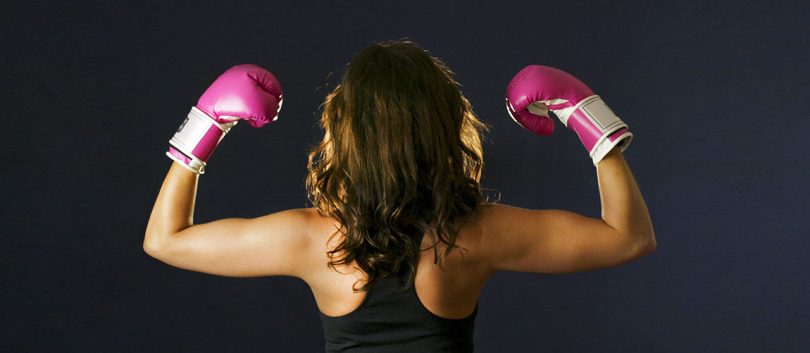These days, most people who spot a looped pink ribbon know exactly what it symbolizes. Even young kids aren’t surprised to see hulking football players supporting the pink movement and sporting bright pink shoes in October, designated as Breast Cancer Awareness Month.
There’s not much that hasn’t turned pink in recent years: stuffed animals, clothes, jewelry, makeup cases, cereal boxes, candy, toasters, vacuum cleaners, car accessories, cell phone cases, nail clippers, tattoo art, pet collars and more.
The Pink Movement
The pink movement, which grew up during the 1990s to focus attention on a frighteningly common but once rarely-discussed disease, is undeniably powerful. It’s also undeniably successful. Compared to just a few decades ago, educational initiatives and research funding have skyrocketed. Today’s patients also have access to a community of support that can bolster their spirits throughout treatment.
But the story of the pink movement isn’t so simple — or entirely rosy.
For many women and their families, pink products are an important source of comfort, power and pride. Others, however, see them differently: as more commercial than inspiring, as a too-pretty cover for an ugly disease, or as an obstacle in their drive to continue defining themselves as individuals, not just cancer patients.
The rest are somewhere in the middle. Take Mary Beth Gibson of James City County, Virginia, who was 41 and busy raising three young boys when she was diagnosed with breast cancer in 2006. Immediately, Gibson, now executive director and co-founder of Here for the Girls — a nonprofit that provides breast education and supports young women with cancer — began to notice pink everywhere.
She was touched by her husband’s vow to wear a pink plastic bracelet until she was cancer-free, and when a friend put a pink ribbon decal on the back of her car. But soon, a barrage of pink gifts from well-meaning loved ones — mostly stuffed bears, jewelry and clothes — was overwhelming. Gibson also never wanted to wear pink herself; it made her feel as if breast cancer had taken over too much of her life.
Eight years later, Gibson’s concern is that the pink ribbon movement has become so sprawling and unregulated that too many people have become immune to its message, while too little is happening to better prevent and treat cancer.
“The campaign has done an incredible job of bringing breast cancer to the forefront,” Gibson says. “For that, of course we should all be grateful. But at this point, is it prompting anyone to modify their behavior? When a woman sees a pink ribbon, she should think, ‘Did I do my self-exam this month? Did I schedule my mammogram?’ Not just, ‘Oh, yeah, breast cancer.’ That’s not going to help us go forward.”
A History of Pink Success
These days, ribbons of seemingly every color have sprouted up to support various causes. Such campaigns, however, are relatively new.
By the 1980s, yellow ribbons had become a statement for bringing home soldiers and prisoners of war. By the early 1990s, AIDS activists had introduced red ribbons to focus attention on that disease. And in the fall of 1991, the Susan G. Komen foundation, which works to end breast cancer worldwide, handed out pink ribbons to every participant in its New York City race.
In 1992, Self Magazine and the Estee Lauder cosmetics company teamed up on a national awareness campaign featuring a pink ribbon. The two originally wanted to incorporate a grassroots effort by a California woman named Charlotte Haley, who had several relatives with breast cancer and was calling for more federal money for prevention. Haley had made a peach-colored ribbon that Self and Estee Lauder wanted to use, but she refused, fearing the campaign’s commercial side — selling cosmetics adorned with a ribbon — would overshadow her message. So the magazine tweaked the color to pink.
The pink movement took off quickly. The cause was a worthy one: breast cancer is so common — today, one in eight women will be diagnosed during her lifetime, according to the American Cancer Society — that almost everyone knows someone who has struggled with it. The illness also attacks an important part of a woman’s sense of femininity.
In addition, survival rates are high compared to other cancers, giving the movement a hopeful air. A report from the ACS and National Cancer Institute found breast cancer survivors made up 41 percent of all cancer survivors in the United States in 2014. Today, the five-year survival rate for women diagnosed with early stage breast cancer tops 99 percent, according to Komen.
Effective marketing, particularly by Komen, has had a major impact. The federal government now devotes more than $850 million a year to research, treatment and prevention, compared to $30 million when Komen was founded in 1982. Komen, which organizes Race for the Cure runs and collects a percentage of proceeds from certain pink ribbon products, has invested more than $2.5 billion.
The pink movement has transformed the way people talk about breast cancer, says Lisa Chacon, a Virginia Beach, Virginia, resident diagnosed eight years ago at age 42. As a teenager, Chacon remembers watching her grandmother battle a disease that no one outside close family members would discuss. The word “cancer” was rarely uttered, much less “breast.”
Twenty-five years later, when Chacon learned she had the same type of cancer, she had many sources for support and answers to her questions. That was tremendously reassuring: she knew she wasn’t in the fight alone, and she could celebrate survival, thanks to advances in diagnostics, treatment and education. Pink became a staple of Chacon’s wardrobe; family members in New Mexico also wore pink when they ran as a team in a Race for the Cure event.
“Pink was about camaraderie, connectedness, hope for me,” she says. “I saw women had survived this, and I was encouraged that I could survive it, too.” And even before she got sick, she adds, the campaign had driven home the importance of annual mammograms at age 40, which led to her early diagnosis. Grateful, Chacon began volunteering for Komen after her diagnosis and now works as development/special events director for its Tidewater affiliate.
Michele Yepez, a 33-year-old Norfolk , Virginia, woman diagnosed with breast cancer December 2013, agrees that the pink movement has helped many women. Yepez, mother to an 11-year-old son and a 2-year-old daughter, has undergone a double mastectomy and four grueling rounds of chemotherapy. “Anything that gets people to talk and raise money for research is inherently a good thing,” she says. “We need to win this fight no matter what. I mean, I have a daughter. I’m terrified this is a gene I’ve given her.”
The Flip Side
No single entity is in charge of all the pink ribbon campaigns in the U.S. Put simply, that means anyone can put a pink ribbon on anything. And that chaos inevitably means some of those products are scams, or that only a tiny percentage of proceeds might actually go to fund breast cancer initiatives.
In 2002, a national watchdog group called Breast Cancer Action launched a campaign called “Think Before You Pink” in response to a flood of pink ribbon products on the market. The campaign pushes for accountability and transparency in fundraising, helps consumers evaluate products and lobbies corporations to avoid ingredients that may raise the risk of cancer.
Breast Cancer Action urges people to ask four questions before buying pink. First, does money go to support a breast cancer program and if so, how much of the purchase price (it could be pennies)? Second, what organization gets the money, and how do they spend it? Third, is there a maximum total amount a company will donate and if so, how are consumers notified if the cap has already been met? Finally, does a product contain toxins with known or suspected links to cancer?
“We’re not saying, ‘Don’t buy anything,’” says Karuna Jaggar, executive director of Breast Cancer Action. “If you feel satisfied that you will be making a difference, then by all means go ahead. We just want consumers to see beyond the ribbon—to realize that a product may not be all they assume it to be.”
If there’s any doubt, Jaggar recommends giving money directly to a breast cancer organization doing the work the donor most believes in, whether that’s research or patient support such as help with transportation and medical expenses.
Sharon Laderberg, executive director of Komen’s Tidewater Affiliate, says buyers looking to support her organization should look for the Komen logo (on Yoplait yogurt lids, for example). That means a company has a third-party agreement with Komen to donate a set percent of proceeds from sales. “And people are always welcome to call us even if our logo is there, to make sure,” she says.
Of money donated to a Komen affiliate, 75 percent stays in the local community for services such as patient education, mammograms, transportation to appointments and wigs, Laderberg says. The other 25 percent goes into a pool at Komen’s national headquarters designated exclusively for research.
If people are looking for gifts, they should realize that some cancer patients feel alienated by pink, Jaggar reminds. “It can be complicated,” she says. “Some women feel it oversimplifies their disease and obscures the really scary, painful, nauseous reality of breast cancer. They feel that it silences them.”
Yepez, like Mary Beth Gibson, had mixed feelings about her mailbox full of pink. What she really wanted was hands-on support: care for her children, home-cooked meals and conversations with friends to feel as normal as possible. “I don’t want to sound ungrateful, because I understand people’s motivation,” she says. “It’s just that I’m trying to get away from making my life about cancer, and it’s kind of thrust on you. All of a sudden, it was like everyone saw me as a cancer patient—not Michele.”
During chemotherapy, Yepez also bonded with people battling all types of cancer; she wishes their diseases got the same amount of attention. Komen leaders reply that the pink campaign has reached beyond breast cancer. “In October, I know some people say, ‘All you see is pink,’” Laderberg says. “Well, that gives us an opportunity to talk about other cancers. We opened the door to that.”
What everyone can agree on is that much remains to be done to figure out what causes breast cancer—and what people can do to prevent it—help women with limited access to care and develop even more effective therapies. All of that will require more than pink ribbons. As Jaggar puts it, “We’re not just going to shop our way out of breast cancer.”
Gibson, a third-generation breast cancer patient, knows the stakes are high. While her grandmother survived the disease, her mother died after a recurrence at age 55. Gibson, whose boys are now 11, 14 and 16, is grateful to be cancer-free after a bilateral mastectomy, chemotherapy, radiation and hormonal therapy. As an advocate, though, she is well aware that not everyone is so lucky.
“My feeling is that the awareness part of the pink ribbon campaign—which was so important—is done,” she says. “So the question is: What do we do next?”







